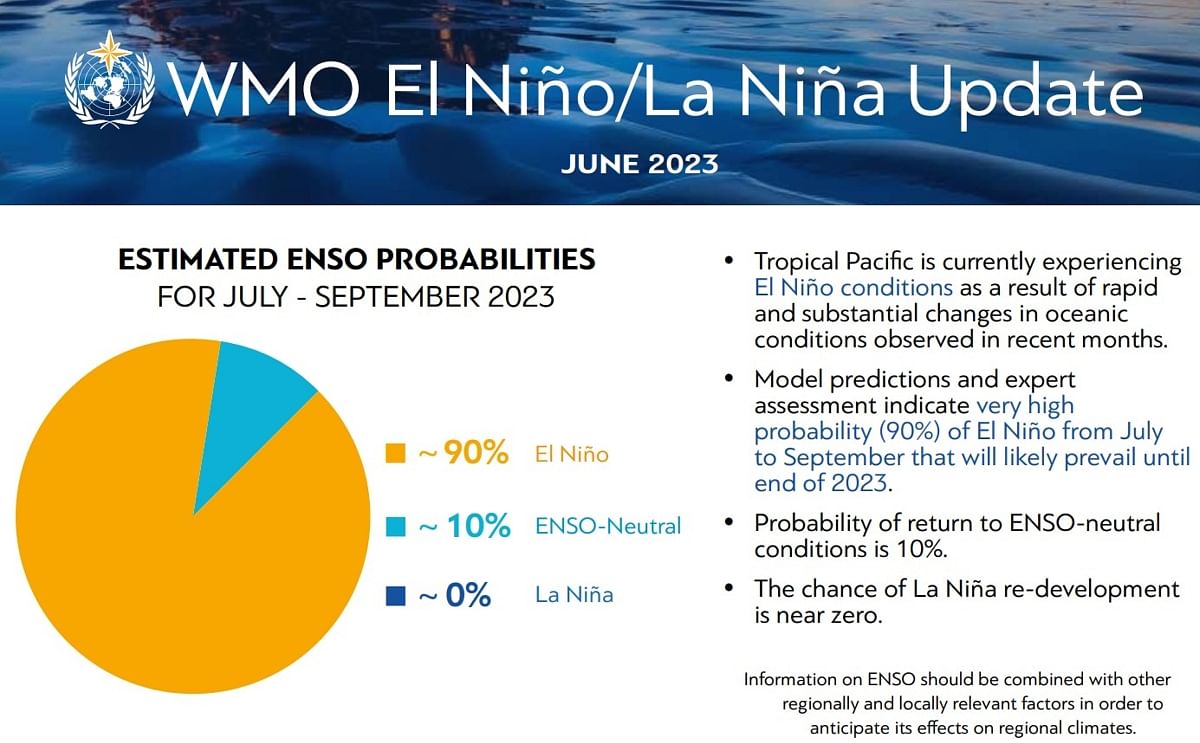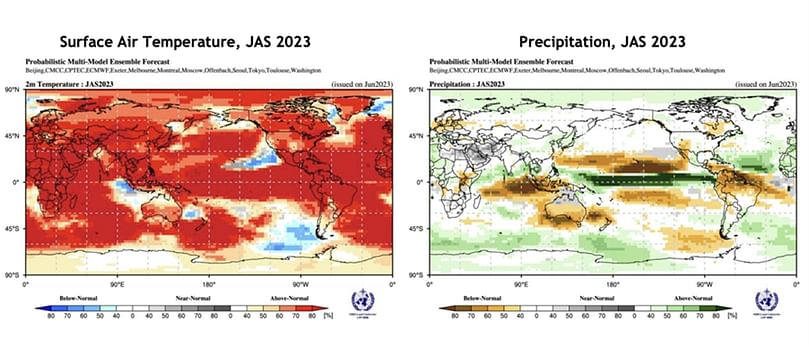World Meteorological Organization (WMO) declares onset of El Niño conditions
World Meteorological Organization declares start of El Niño; what to expect

El Niño conditions have developed in the tropical Pacific for the first time in seven years, setting the stage for a likely surge in global temperatures and disruptive weather and climate patterns.
A new Update from the World Meteorological Organization (WMO) forecasts that there is a 90% probability of the El Niño event continuing during the second half of 2023. It is expected to be at least of moderate strength. The WMO Update combines forecasts and expert guidance from around the world.
Petteri Taalas, Secretary-General Prof. at WMO:
In anticipation of the El Niño event, a WMO report released in May predicted that there is a 98% likelihood that at least one of next five years, and the five-year period as a whole, will be warmest on record, beating the record set in 2016 when there was an exceptionally strong El Niño.
The WMO report in May, led by the UK’s Met Office with partners around the world, also said there is a 66% likelihood that the annual average near-surface global temperature between 2023 and 2027 will temporarily be more than 1.5°C above pre-industrial levels for at least one year.
Chris Hewitt, Director of Climate Services Prof. at WMO:
The effect on global temperatures usually plays out in the year after its development and so will likely be most apparent in 2024. The average global temperature in 2022 was about 1.15 °C above the 1850-1900 average because of the cooling triple-dip La Niña.
El Niño events are typically associated with increased rainfall in parts of southern South America, the southern United States, the Horn of Africa and central Asia. In contrast, El Niño can also cause severe droughts over Australia, Indonesia, parts of southern Asia, Central America and northern South America.
During the Boreal summer, El Niño’s warm water can fuel hurricanes in the central/eastern Pacific Ocean, while it could hinder hurricane formation in the Atlantic Basin. Generally, El Niño has the opposite effect of the recent La Niña, which ended earlier in 2023.
Current situation and outlook
Since February 2023, monthly average sea surface temperature anomalies in the central-eastern equatorial Pacific have warmed significantly, rising from nearly half degree Celsius below average (-0.44 in February, 2023) to around half degree Celsius above average (+0.47 in May, 2023).
In the week centered on June 14, 2023, the warm sea surface temperature anomalies have continued to increase, reaching a value of +0.9 degrees Celsius.
The collective evidence from both oceanic and atmospheric observations strongly points towards the presence of El Niño conditions in the Pacific. However, some uncertainty remains because of only weak ocean-atmosphere coupling, which is crucial for the amplification and sustenance of El Niño. It is anticipated that it will take approximately another month or so to witness a fully established coupling in the tropical Pacific.
Global Seasonal Climate Update
El Niño and La Niña are major – but not the only - drivers of the Earth’s climate system. In addition to the long-established ENSO Update, WMO now also issues regular Global Seasonal Climate Updates (GSCU), which incorporate influences of the other major climate drivers such as the North Atlantic Oscillation, the Arctic Oscillation and the Indian Ocean Dipole.
As warmer-than-average sea surface temperatures are generally predicted over oceanic regions, they contribute to widespread prediction of above-normal temperatures over land areas. Without exception, positive temperature anomalies are expected over all land areas in the Northern and Southern Hemisphere.
Predictions for rainfall in the forthcoming three months are similar to some of the canonical rainfall impacts of El Niño. The WMO ENSO and Global Seasonal Climate Updates are based on forecasts from WMO Global Producing Centres of Long-Range Forecasts and are available to support governments, the United Nations, decision-makers and stakeholders in climate sensitive sectors to mobilize preparations and protect lives and livelihoods.
National Meteorological and Hydrological Services (NMHSs) will closely monitor the evolution of El Niño conditions and the associated impacts on temperature and precipitation at national and local level. WMO will provide updated outlooks during the coming months as needed.
 The World Meteorological Organization is the United Nations System’s authoritative voice on Weather, Climate and Water.
The World Meteorological Organization is the United Nations System’s authoritative voice on Weather, Climate and Water.
A new Update from the World Meteorological Organization (WMO) forecasts that there is a 90% probability of the El Niño event continuing during the second half of 2023. It is expected to be at least of moderate strength. The WMO Update combines forecasts and expert guidance from around the world.
Petteri Taalas, Secretary-General Prof. at WMO:
"The onset of El Niño will greatly increase the likelihood of breaking temperature records and triggering more extreme heat in many parts of the world and in the ocean. The declaration of an El Niño by WMO is the signal to governments around the world to mobilize preparations to limit the impacts on our health, our ecosystems and our economies."El Niño occurs on average every two to seven years, and episodes typically last nine to 12 months. It is a naturally occurring climate pattern associated with warming of the ocean surface temperatures in the central and eastern tropical Pacific Ocean. But it takes place in the context of a climate changed by human activities.
"Early warnings and anticipatory action of extreme weather events associated with this major climate phenomenon are vital to save lives and livelihoods."
In anticipation of the El Niño event, a WMO report released in May predicted that there is a 98% likelihood that at least one of next five years, and the five-year period as a whole, will be warmest on record, beating the record set in 2016 when there was an exceptionally strong El Niño.
The WMO report in May, led by the UK’s Met Office with partners around the world, also said there is a 66% likelihood that the annual average near-surface global temperature between 2023 and 2027 will temporarily be more than 1.5°C above pre-industrial levels for at least one year.
Chris Hewitt, Director of Climate Services Prof. at WMO:
"This is not to say that in the next five years we would exceed the 1.5°C level specified in the Paris Agreement because that agreement refers to long-term warming over many years. However, it is yet another wake up call, or an early warning, that we are not yet going in the right direction to limit the warming to within the targets set in Paris in 2015 designed to substantially reduce the impacts of climate change."According to WMO’s State of the Global Climate reports, 2016 is the warmest year on record because of the “double whammy” of a very powerful El Niño event and human-induced warming from greenhouse gases.
The effect on global temperatures usually plays out in the year after its development and so will likely be most apparent in 2024. The average global temperature in 2022 was about 1.15 °C above the 1850-1900 average because of the cooling triple-dip La Niña.
El Niño events are typically associated with increased rainfall in parts of southern South America, the southern United States, the Horn of Africa and central Asia. In contrast, El Niño can also cause severe droughts over Australia, Indonesia, parts of southern Asia, Central America and northern South America.
During the Boreal summer, El Niño’s warm water can fuel hurricanes in the central/eastern Pacific Ocean, while it could hinder hurricane formation in the Atlantic Basin. Generally, El Niño has the opposite effect of the recent La Niña, which ended earlier in 2023.
Current situation and outlook
Since February 2023, monthly average sea surface temperature anomalies in the central-eastern equatorial Pacific have warmed significantly, rising from nearly half degree Celsius below average (-0.44 in February, 2023) to around half degree Celsius above average (+0.47 in May, 2023).
In the week centered on June 14, 2023, the warm sea surface temperature anomalies have continued to increase, reaching a value of +0.9 degrees Celsius.
The collective evidence from both oceanic and atmospheric observations strongly points towards the presence of El Niño conditions in the Pacific. However, some uncertainty remains because of only weak ocean-atmosphere coupling, which is crucial for the amplification and sustenance of El Niño. It is anticipated that it will take approximately another month or so to witness a fully established coupling in the tropical Pacific.
Global Seasonal Climate Update
El Niño and La Niña are major – but not the only - drivers of the Earth’s climate system. In addition to the long-established ENSO Update, WMO now also issues regular Global Seasonal Climate Updates (GSCU), which incorporate influences of the other major climate drivers such as the North Atlantic Oscillation, the Arctic Oscillation and the Indian Ocean Dipole.
As warmer-than-average sea surface temperatures are generally predicted over oceanic regions, they contribute to widespread prediction of above-normal temperatures over land areas. Without exception, positive temperature anomalies are expected over all land areas in the Northern and Southern Hemisphere.
Predictions for rainfall in the forthcoming three months are similar to some of the canonical rainfall impacts of El Niño. The WMO ENSO and Global Seasonal Climate Updates are based on forecasts from WMO Global Producing Centres of Long-Range Forecasts and are available to support governments, the United Nations, decision-makers and stakeholders in climate sensitive sectors to mobilize preparations and protect lives and livelihoods.
National Meteorological and Hydrological Services (NMHSs) will closely monitor the evolution of El Niño conditions and the associated impacts on temperature and precipitation at national and local level. WMO will provide updated outlooks during the coming months as needed.

Probabilistic forecasts of surface air temperature and precipitation for the season July-September 2023. The baseline period is 1993–2009
¿Te gustaría recibir noticias como esta por correo electrónico? ¡Únete y suscríbete!
Get the latest potato industry news straight to your WhatsApp. Join the PotatoPro WhatsApp Community!
Contenido Patrocinado
Contenido Patrocinado
Contenido Patrocinado
Contenido Patrocinado










